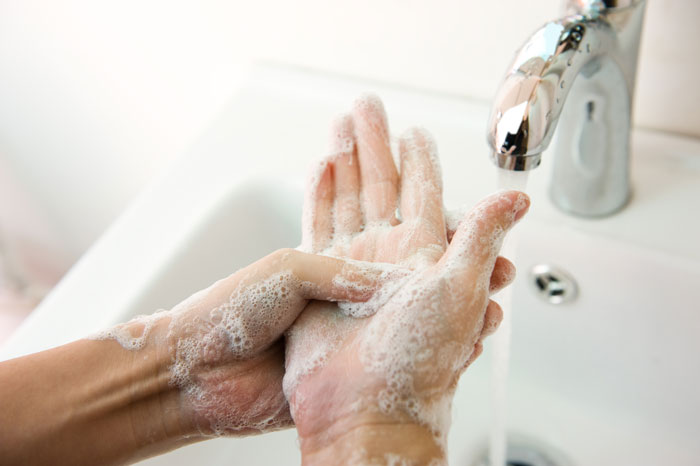Food hygiene’s dirty secret
Posted: 1 November 2017 | Paul Jakeway | Director | Deb | 1 comment
Food and beverage companies could be putting themselves at severe risk of suffering a food safety incident, without even knowing it, potentially leading to lawsuits and ruinous fines. Deb’s Paul Jakeway explains further.


WASHING UP: Every year more than a million legal cases are brought against businesses that fail to ensure food safety. Any of these cases could potentially carry a fine of up to £1.5m.
Estimates from the Food Standards Agency (FSA) reveal that roughly 5. 5 million people in the UK are affected by foodborne illnesses each year. These illnesses (more commonly known as food poisoning) can develop from a number of sources, such as undercooked meat that harbours potentially dangerous bacteria or food that is meant to be refrigerated, but has been left out for a lengthy amount of time.
Cross-contamination is another common cause of food poisoning, occurring when bacteria and viruses transfer onto food from contaminated surfaces, equipment or other food. People can also be a major source of cross-contamination – usually transferring contaminants via their hands.
Understanding the threat
Two types of bacteria which present a risk are Campylobacter and Listeria. Campylobacter is considered to be responsible for more than 280,000 cases of food poisoning each year. According to the FSA, Campylobacter is likely to be responsible for more than 100 deaths a year, costing the UK economy about £900 million.
Around four in five cases of Campylobacter poisoning in the UK come from contaminated poultry, but the pathogen is also found in red meat, unpasteurised milk, and untreated water. It spreads very easily, and has a low infective dose, which means that only a small amount of bacteria in a piece of food can be enough to cause illness.
Listeria causes a disease called listeriosis, which can also lead to meningitis or encephalitis (a brain infection) in severe cases. People at an increased risk of developing listeriosis include those over 65 years of age, pregnant women and their unborn babies, and babies less than one month old.
Listeria is most commonly found in unpasteurised milk and dairy products made from unpasteurised milk. Symptoms are typically similar to flu and gastroenteritis, but may also infect areas such as the brain, spinal cord membranes, or the bloodstream. Listeria can survive in low temperatures, which means it can grow to potentially harmful levels in food stored in a fridge.
Controlling the risks
The outcomes from these foodborne illnesses can be severe and costly. So, to avoid the risk of poor food safety, cross-contamination needs to be avoided at all costs.
Strict regulations are in place to ensure this: under the Food Hygiene Regulation 2006 and The Food Hygiene Regulations Great Britain 2006, all ‘food handlers’ are required to be supervised, instructed, and trained in food hygiene practices. It states that they should observe good personal hygiene and routinely wash their hands when handling food.
Companies also need to adhere to a Hazard Analysis and Critical Control Point (HACCP) system. The system identifies hazards in the workplace, such as moments when cross-contamination could occur, and calculates the likely incident rate. Such a system helps food and beverage businesses look at how they handle food, and introduces procedures to make sure the food produced is safe to eat.
Importance of hand hygiene compliance
Effective hand hygiene is widely seen as one of the most effective ways to prevent the cross-contamination of food. Employees in food handling environments need to frequently decontaminate their hands – not just before and after contact with food, but before and after breaks, and at key moments such as after using the washroom, coughing, sneezing or touching contaminated surfaces.
And yet: research demonstrates that hand-hygiene compliance is not always where it needs to be. Some estimates show that 39 per cent of food handling staff do not wash their hands after visiting the toilet, while 53 per cent do not wash their hands before preparing food. This lack of compliance will have an impact on swab test failure rates, and can significantly raise the risk of cross-contamination.
What can the food industry do to change the situation? Once a HACCP system has been effectively implemented, it should be used to develop a fully integrated skin care programme – a four step system that helps drive hand hygiene compliance, while also taking into account the skin health of employees.
Four steps to handling food safely
A specialist skin care programme identifies four crucial steps for hand hygiene in food handling environments: applying protective creams (where appropriate) before work; using hand cleansers after hands become contaminated; sanitising hands in situations where the skin is visibly clean, but potentially contaminated; and applying restorative creams at the end of the working day.
Protective creams can reduce direct contact with specific physical contaminants, help retain natural lipids and moisture in the skin, and make the skin easier to clean. Some manufacturers have created products specifically formulated for the food industry: they protect hands in wet-working conditions, improve comfort and skin strength when wearing gloves, and provide an additional barrier for skin that is exposed to refrigeration environments.
Cleansers are essential to remove dirt and contaminants from the skin during the work day, especially before entering productions areas, after breaks and visits to the toilet. Antibacterial hand wash products are a good choice for hygiene-sensitive food-handling environments. Foam-based products are easier to rinse than traditional liquid or lotion soaps, making them especially suitable for environments where hands are being washed frequently.
Sanitisers, meanwhile, should be used in addition to hand washing before entering locations such as food production areas, where a higher level of sanitisation is required. Sanitisers kill germs and bacteria when hands are visibly clean but could be contaminated, and are therefore recommended after coughing, sneezing, or touching surfaces that are likely to be contaminated.
Advanced cleansers and sanitisers are now capable of killing 99. 999 per cent of transient bacteria. This rate of effectiveness is known as Log 5 reduction. Products that meet Log 5 requirements are 100 times more effective than the more common Log 3 products, which kill 99. 9 per cent of transient bacteria.
Some sanitisers have also advanced to be fully capable of killing viruses. Combining a highly effective broad spectrum biocidal efficacy with safety and user preference, they meet the highest levels of European microbiological standards.
When choosing antibacterial hand wash and sanitisers, it is important to look for products whose formulas have been independently tested and assessed by experts to demonstrate that the products are non-tainting and do not influence the quality and safety of food products.
Restorative products are important too. Applied at the end of the working day, they moisturise, nourish and condition the skin, improving its strength and preventing it from becoming dry or damaged.
Why use a specialist skin care company?
Any products should always be sourced from a reputable company that offers skin care and hand hygiene advice, guidance and technical support.
A skin care specialist should provide site audits, an essential service conducted to help understand the workplace facilities, working environments, workflow, hazards and hand hygiene requirements. From this, recommendations on the right products for the right places can be made to establish best practice. Regular ongoing audits ensure that the system implemented continues to be effective.
The installation of specifically designed dispensers for use with hygienically-sealed cartridge cleansers, sanitisers, and creams is strongly advised. Such systems provide the most hygienic skin care, by reducing the risk of contamination that comes from bacteria in the environment or even the hands of the people handling and refilling the dispensers.
Training is key to compliance
For a skin care and hand hygiene programme to be effective, education is crucial. Skin care experts can provide training programmes and materials such as videos, leaflets, brochures, and posters. They can provide information boards and Skin Hygiene Centres – made from a special material which does not harbour microbes. Staff meetings are also a good way to keep skin care on everyone’s mind on a day-to-day basis.
There is a clear way forward for the food industry to tackle food poisoning and cross-contamination – and that is for workplaces to introduce an integrated skin care system. By doing this, food and beverage businesses can not only comply with food hygiene regulation, they can create a hand hygiene culture that does not tolerate cross-contamination. As well as this, employers can vastly improve the skin health of their workers – keeping their hands healthy and the food they serve safe.












Very informative helpful article. I appreciate your work.